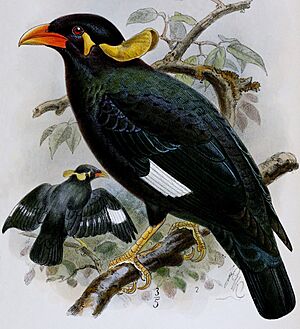Nias hill myna facts for kids
Quick facts for kids Nias hill myna |
|
|---|---|
 |
|
| Conservation status | |
| Scientific classification | |
| Genus: |
Gracula
|
| Species: |
robusta
|
The Nias hill myna (Gracula robusta) is a very special bird that belongs to the starling family. It lives only on Nias Island and a few other small islands near Sumatra in Indonesia. This amazing bird is known for being one of the best "talkers" in the bird world! Sadly, it is also a critically endangered species, meaning it's very close to disappearing forever.
What Does It Look Like?
This myna is a large and strong bird, often looking a bit like a crow. It's the biggest of all the hill mynas and might even be the largest living species in the entire starling family! It can grow to be about 30 to 36 centimeters long, which is roughly the length of a school ruler and a half.
The Nias hill myna has shiny black feathers that look purple in the light. It has bright orange-yellow skin patches on its head and big, soft yellow flaps of skin called 'wattles' on the sides of its head and neck. When it flies, you can easily spot large white patches on its wings. Its strong beak is mostly red, and its powerful legs are bright yellow.
Life in the Wild
Nias hill mynas spend most of their time in trees, living in groups within hill forests. Like most starlings, these birds eat many different kinds of food. Their diet includes fruit, sweet nectar from flowers, and insects.
Why Is This Bird in Danger?
The Nias hill myna is very popular because of its amazing ability to copy human speech. This has led to many birds being caught and sold illegally as pets. This unlawful capture for the pet trade is a huge problem for the species.
Another big threat is the destruction of its home. Most of the natural forests where these birds live have been cut down. This means they have fewer safe places to live and find food.
In 1990, a bird expert named Dymond visited Nias Island for 17 days but couldn't find any Nias hill mynas. For a while, people thought they might have completely disappeared from the wild. However, in 2015, some scientists from the Czech Republic were excited to find a few wild Nias hill mynas! This discovery gave hope that the species could still be saved.


